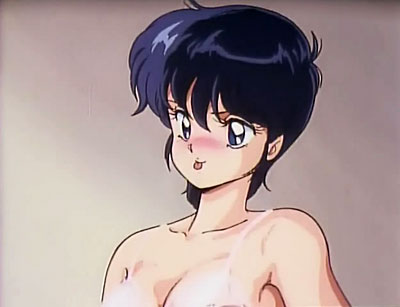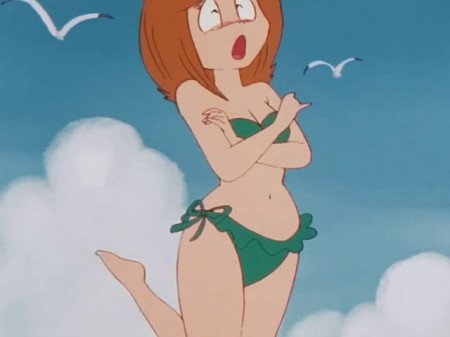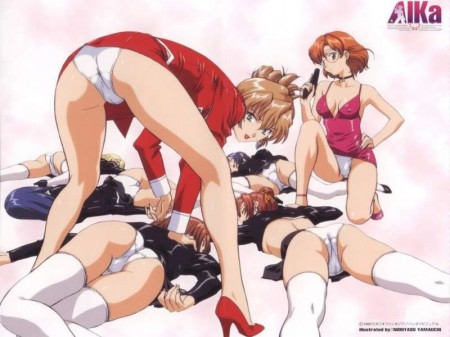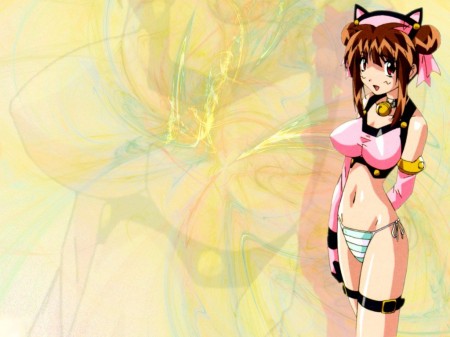Ask John: What are the Best Vintage Fan Service Anime?

Question:
What are the best fanservice anime from 70s to the 90s?
Answer:
It’s ironic to realize that in the modern era of explicit, sexually provocative television anime including Girls Bravo, Kanokon, Ladies vs Butlers, Kiss X Sis, Queen’s Blade, Ikkitousen, Strike Witches, Sekirei, Hyakka Rouran, Manyuu Hikencho, just to name a few, “fan service” as we know it today is actually a relatively recent evolution in anime history. Broadly speaking, “fan service” is any extraordinary bounty for fans, which may range from exceptionally well animated combat, to the inclusion of big guns in inappropriate anime (for example, Cybot Robotachi, Dream Hunter Rem, and Dragon Ball), to unexpected cameos like a Gundam Haro appearing in the 1983 Crusher Joe movie, to gratuitous nudity. Today it’s the later instance that’s immediately associated with the phrase “fan service,” largely thanks to the famous “Gainax jiggle” from 1988’s Gunbuster OVA series. But, in fact, contemporary sexually gratuitous nudity in television anime didn’t appear until 2001’s Hanaukyo Maid-tai TV series.
Nudity has always been present in anime, first appearing in 1963’s Sennin Buraku, the third ever anime television series following Otogi Manga Calendar and Tetsuwan Atom. But the 1960s and 70s were a very conservative era for anime. 1973’s Cutey Honey is legitimately credited as the first anime to consciously include nudity for the purpose of “fan service,” but the nudity in Cutey Honey is as tame as transformation sequences in modern shoujo anime for pre-adolescent girls. The 1970’s actually didn’t offer a lot of anime starring female characters. Many of the anime that did, including La Seine no Hoshi, Ribbon no Kishi, and Versailles no Bara depicted women disguising themselves as men. Other anime from the era, including Gowapper 5 Godam, Haikara-san ga Tooru, and Yakyukyo no Uta depicted women adopting masculine roles.
The 1981 Maicchingu Machiko-sensei television series may be the first anime to prominently characterize itself as a “panty flashing” anime, but by today’s standards the show is quaint and very tame. 1983’s Time Bokan Series: Itadakiman included scenes of conscious “fan service,” but the show itself was certainly not a “fan service anime.” Although 70’s anime including Cleopatra and Kanashimi no Belladonna were considered erotic, true pornographic anime didn’t emerge until 1984’s Lolita Anime & Cream Lemon OVA series. So, practically speaking, graphic sex in anime wasn’t introduced until 1984. The following year saw a sudden dramatic increase in prominent nudity in anime including Vampire Hunter D, Fandora, Dirty Pair, and Iczer-One, yet none of these titles are “fan service” anime due to excessive nudity.
The 1987 late-night TV show Midnight Anime Lemon Angel may be the first anime to be consciously designed as risqué titillation for television broadcast, but by today’s standards much of the show isn’t even recognizable as overt fan service because it’s so modest. The 1987 Pantsu no Ana and 1988 Doctor Chichibuyama OVAs are both sex comedies, the later an especially hilarious one, but neither feature much nudity. 1989’s three-episode Konai Shasei OVA series may be the era’s best “fan service” anime thanks to its extremely risqué but not explicit humor and the involvement of luminary staffers including Satoshi Urushihara & Yuji Moriyama.

Even in the 1990s excessive “fan service” was excluded from TV anime. The 1993 OVA Desert Rose featured scantily clad ladies but provided even more “fan service” by depicting those ladies with machine guns. The following year’s Dirty Pair Flash OVA series placed heavy emphasis on its suggestive transformation scenes but didn’t include overt nudity. 1994’s Plastic Little OVA can be directly traced back as a progenitor of modern fan service anime. It’s also a rare exception for its era. The 1996 Maze Bakunetsu Jikuu OVA included nudity and plenty of risqué humor but wasn’t a “fan service” anime in the contemporary sense. 1996’s Elf wo Karumono Tachi promised to be the first modern-era “fan service” anime but actually minimized its titular “elf stripping.” It’s actually the 1997 AiKA OVA series that really introduced modern-era “fan service.” AiKA is the only “fan service” anime of the era that holds its own against contemporary descendants. But it was still an OVA series rather than a TV anime.
1988’s Let’s Nupu-Nupu TV series was a sex comedy, but its humor was almost entirely in its dialogue rather than its visuals. The 1988 Yoiko TV series may be one of the earliest true “fan service” anime TV series because it was filled with nudity and sex jokes, but it also feels very different from contemporary “fan service” anime because its nudity and even its sex gags were innocent and humorous, circumstantial rather than provocative like today’s “fan service.” The 1999 Nanako Kaitai Shinsho OVA series existed for the sole purpose of “fan service,” yet it didn’t include any graphic nudity. The 1999 Colorful TV series revolved around panty flashes and sex gags but, again, didn’t include any nudity. Tonally similar to Yoiko, the 1999 Ippatsu Kiki Musume television series was filled with nudity and sex gags, but once again, the nudity was always circumstantial and the sexual references included for laughs, not titillation, making the show very different in tone and feel from 2000’s “fan service” anime.
We now think of “fan service” anime as anime in which attractive nude girls are sexually enticing. Anime like that, especially for television broadcast, just didn’t exist (with very rare exceptions) prior to 2001. Certainly anime from the 70s to 90s included “fan service,” but non-pornographic anime that existed primarily or predominantly for the purpose of delivering T&A to eager viewers practically didn’t exist before the 2000s.
Add a Comment
You must be logged in to post a comment.





You left out the 1990 OVA series, Devil Hunter Yohko.